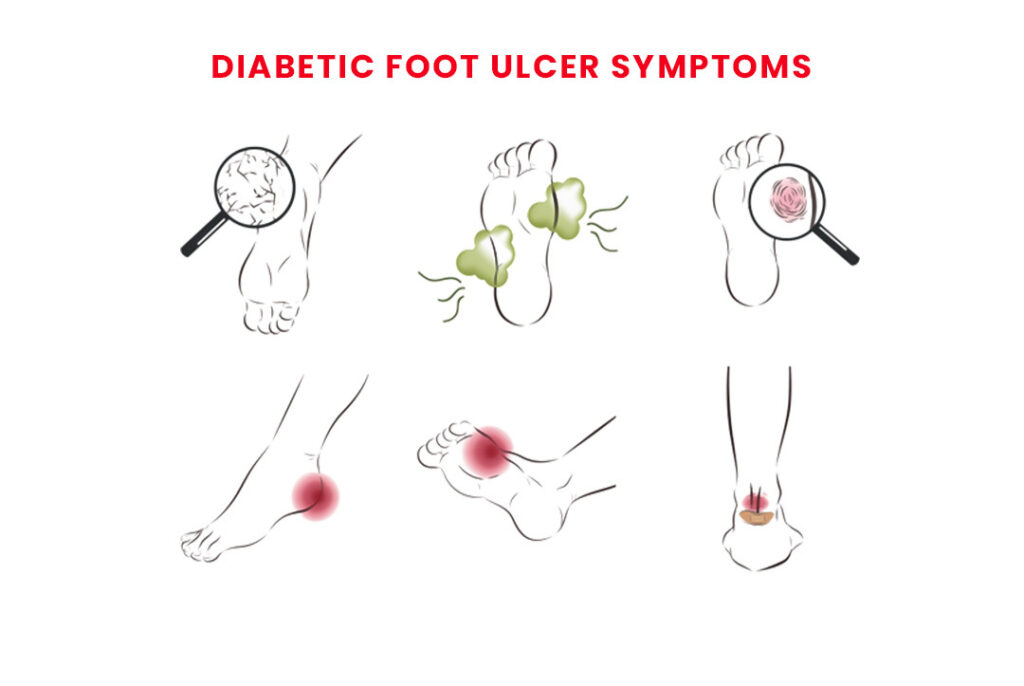Diabetic foot ulcers are a common complication of diabetes, affecting approximately 15% of people with diabetes during their lifetime. These open sores can be painful, dangerous, and even life-threatening if left untreated. In this blog post, we will discuss the symptoms of diabetic foot ulcers, the best treatment options available in Hyderabad, and how to prevent them from occurring in the first place.
Symptoms of Diabetic Foot Ulcers
The most common symptom of a diabetic foot ulcer is pain or discomfort on the bottom of your feet. Other signs include swelling around the affected area, redness or discoloration of the skin near the ulcer site, and drainage from the wound itself. If you experience any of these symptoms it is important to seek medical attention as soon as possible to prevent further complications from developing.

In order to diagnose diabetic foot ulcers, doctors will typically begin with a physical examination and then use imaging tests such as magnetic resonance imaging (MRI) or computed tomography (CT) scans to get a better understanding of the underlying condition. Doctors may also take tissue samples from the wound in order to confirm their diagnosis and rule out any other potential causes.
Diabetic Foot Ulcer Treatment in Hyderabad
The best treatment for diabetic foot ulcers depends on several factors such as the severity of the wound and whether there are any underlying infections present. Offloading devices like special shoes or braces reduce pressure on the affected area. In more serious cases surgery may be necessary to remove any damaged tissue and promote healing. Neuropathy makes it difficult to detect injuries or infections early on and can increase your risk of developing an ulcer.

Your doctor will perform a physical exam and likely order lab tests or imaging studies to determine whether there is an infection present or if there is any tissue damage that needs to be addressed. Once your diagnosis has been established, your doctor will recommend a course of treatment which may include antibiotics, wound dressings, debridement (removal of dead tissue), offloading (reducing pressure on the affected area), or surgery.
In certain cases, hyperbaric oxygen therapy may also be recommended. This type of therapy involves breathing 100% oxygen while inside a pressurized chamber to promote healing by increasing oxygen levels in the body’s tissues.
Hyperbaric Oxygen Therapy in Hyderabad
If you have been diagnosed with DFUs and live in Hyderabad, India then you may be able to receive hyperbaric oxygen therapy at one of several medical centers located within city limits.

Hyperbaric oxygen therapy is considered one of the most effective treatments for diabetic foot ulcer healing because it helps increase blood flow to the affected area while providing essential nutrients needed for healing. Additionally, it helps reduce inflammation and edema while promoting new cell growth.
Preventing Diabetic Foot Ulcers
The best way to treat a diabetic foot ulcer is by preventing it from occurring in the first place! Regularly inspect your feet for any cuts or sores is key; if caught early enough these wounds can often be treated before they develop into an ulcer.

Additionally, taking steps to control your blood sugar levels can help reduce your risk of developing an ulcer as well as other complications associated with diabetes such as nerve damage or poor circulation. Lastly wearing comfortable shoes that fit properly can help reduce pressure on your feet which can lead to serious injury or infection down the line.
Conclusion:
Diabetic foot ulcers are a common complication among people with diabetes that can be both painful and dangerous if left untreated. However, with proper care and regular monitoring, you can greatly increase your chances of avoiding these types of wounds altogether! The best treatment for diabetic foot ulcers depends on several factors but commonly includes antibiotics, debridement (removal of dead tissue), wound dressings, offloading devices (special shoes/braces), and occasionally surgery depending on severity.
Taking steps to control your blood sugar levels along with inspecting your feet regularly will also help decrease your risk of developing an ulcer while also reducing other potential complications associated with diabetes such as nerve damage or poor circulation. With all this in mind, it’s important to remember that prevention is always better than cure when it comes to taking care of yourself!
(FAQs):
1. How long does Foot Ulcer Surgery take?
Foot ulcer surgery usually takes between 1-3 hours, depending on the severity of the wound or ulcer being treated.
2. How Do I Know If I Need Foot Ulcer Surgery?
Your doctor will conduct tests to diagnose your condition before recommending any type of treatment or therapy—including surgery if necessary—to treat your specific case effectively and safely.

